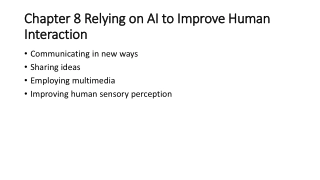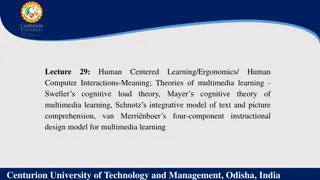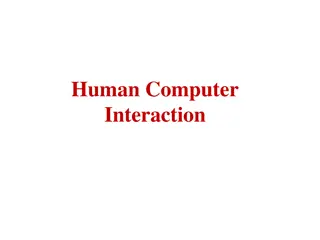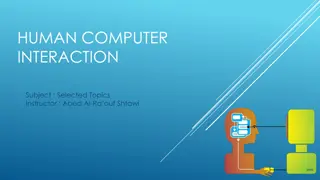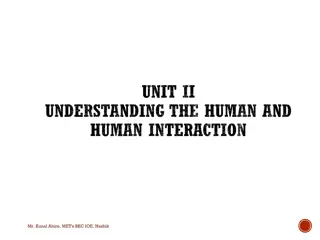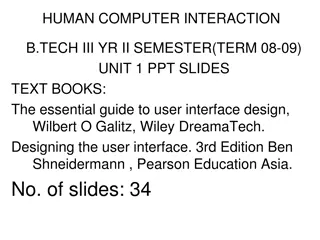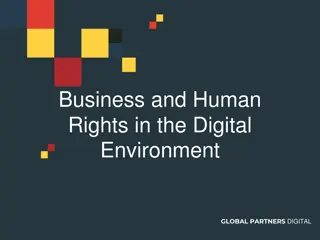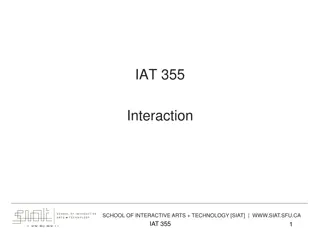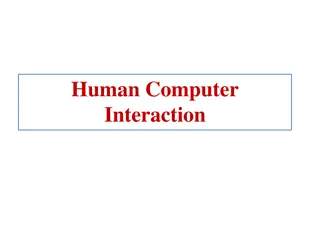Enhancing Human Interaction with AI: Communication Innovations
Exploring the role of AI in improving human interaction, this chapter delves into new ways of communicating, using multimedia, and enhancing sensory perception. From electronic noses to new alphabets like emoticons and emojis, AI is revolutionizing how we exchange ideas and express emotions.
1 views • 19 slides
Understanding the Business Environment and its Impact
Davis and Keith define the business environment as the aggregate of all conditions, events, and influences affecting a business. It is a multi-faceted and dynamic entity with far-reaching impacts requiring adaptability. The inter-relationship between business and its environment is vital for surviva
9 views • 15 slides
Overview of Human Factors and Automotive Standards YouTube Series
This YouTube series, led by Paul Green from the University of Michigan, covers human factors and automotive standards. It includes topics like introduction to standards, core human factors standards, automotive human factors standards, human-computer interaction standards, and SAE vehicle standards.
7 views • 9 slides
Evolution of Human-Environment Relationship Through History
The evolution of human-environment relationships can be traced through four key stages - from hunting and food gathering in early human history to the modern era of science, technology, and industrialization. Each phase reflects changing attitudes towards nature and resource utilization, highlightin
0 views • 10 slides
Understanding Human Rights in Queensland Government Work
The Human Rights Act of 2019 in Queensland outlines protected rights such as equality, freedom of expression, and fair trial. All public service employees must adhere to these rights, ensuring decisions and actions respect human rights. This act applies to everyone in the Queensland Government, with
2 views • 13 slides
Impact of Human Population Growth on Environment and Welfare
The rapid growth of the human population is placing immense pressure on the environment, leading to increased demand for resources like food, water, and shelter. The effects of human activity on the environment have escalated significantly over the years due to population expansion. High birth rates
0 views • 8 slides
Understanding the Basic Concept of Human Rights in Modern Jurisprudence
Human rights are natural and inalienable, essential for human life, based on universal principles. The concept of human rights is both simple and complex, requiring societal development and political will for implementation. Rooted in natural law theory, human rights have evolved from natural law to
1 views • 24 slides
Understanding Human-Environment Interaction: Environmental Determinism vs. Possibilism
Human-environment interaction is a two-way process shaping cultures and behaviors. Explore the theories of environmental determinism and possibilism, which offer contrasting views on the influence of physical conditions on human societies. Environmental determinism emphasizes the impact of the envir
0 views • 18 slides
Understanding Human Perception and Interaction in HCI
Human-Computer Interaction (HCI) involves the study of how humans interact with computers using various input and output channels such as vision, hearing, touch, and memory. Vision is crucial as it is the primary source of information, while hearing and touch play significant roles in conveying info
1 views • 12 slides
Analyzing Interaction Effects in Composite-Based SEM
Explore the concept of interaction effects in composite-based structural equation modeling (SEM) through topics like the logic of interaction, estimating effects, multigroup analysis, and visualizing effects. Learn about moderators, their role in relationships between variables, and techniques for a
1 views • 23 slides
Understanding Media Ecology: Impact of Communication Technology
Media ecology is a theoretical concept analyzing the influence of media and communication technology on human culture. Neil Postman, a prominent figure in the field, delves into how communication media affect human perception, understanding, and values. This study views media as environments shaping
4 views • 23 slides
Human-Environment Interaction in Latin America
Latin America's geography has influenced human activities throughout history. The ancient civilizations like the Inca used innovative techniques such as terraced farming in the Andes. Modern agricultural practices like slash-and-burn in the Amazon and urbanization trends highlight the ongoing human-
1 views • 11 slides
Understanding the Business Environment and its Impact on Education
The business environment encompasses all external and internal factors that influence a business. It is dynamic, multi-faceted, and requires adaptability for survival. Businesses interact closely with the environment, with limited capacity to influence it. The components of the internal environment
2 views • 20 slides
Understanding Human-Computer Interaction and Cognitive Learning Theories
Human-Computer Interaction (HCI) focuses on how people interact with computers, while theories like Sweller's Cognitive Load Theory and Mayer's Cognitive Theory of Multimedia Learning explain how individuals process information. These theories emphasize optimizing learning by managing cognitive load
4 views • 8 slides
Understanding Human-Computer Interaction and Input Devices
Human-Computer Interaction involves the interaction between users and computers, exploring various input devices such as keyboards, handwriting recognition, and pointing devices. Learn about the evolution from batch data entry to modern forms of interaction, including speech recognition and stylus i
0 views • 12 slides
Understanding Human Behavior: Insights for Social Workers
This material delves into the intricacies of human behavior, exploring factors influencing behavior such as heredity, environment, intelligence, needs, and motives. It covers the concept of human behavior, stages in life from conception to old age, and theories of human development by eminent psycho
2 views • 71 slides
Understanding Interaction Effects in Regression Analysis using SAS 9.4
Regression models help analyze effects of independent variables (IVs) on dependent variables (DVs, like weight loss from exercise time). Interactions explore how one IV's effect can be modified by another IV (moderating variable, MV). In this seminar's purpose, techniques to estimate, test, and grap
0 views • 137 slides
Understanding Environmental Geology and Surface Processes
Geology in relation to the environment involves studying Earth's geological processes, both surface and deep, and their impacts on nature and human activities. Environmental geology focuses on the interaction between humans and the Earth's near-surface environment, addressing hazards like erosion, f
0 views • 71 slides
Understanding Human-Computer Interaction: CLI vs. GUI
Explore the evolution of Human-Computer Interaction (HCI) from its history to the advent of Command Line Interfaces (CLI) and Graphical User Interfaces (GUI). Learn about the advantages, disadvantages, applications, and how CLI and GUI differ in user interaction paradigms.
0 views • 19 slides
Understanding Geography: The Study of Earth's Features and Human Interaction
Geography is the study of the Earth's physical and human features, their interaction, and how location impacts people's lives. It involves defining terms like longitude, latitude, equator, and prime meridian to understand relative and absolute locations. Geography helps us appreciate the nature of p
0 views • 14 slides
Understanding Human-Machine Interaction: A Comprehensive Overview
This comprehensive overview explores the intricacies of human-machine interaction, delving into topics such as output modalities, interacting machines, complex interfaces, real-life applications, examples, neuroplasticity effects, training dynamics, and key concepts in HMI design. Covering a wide ar
0 views • 11 slides
The Link Between Democracy and Human Rights
The core of democracy lies in promoting equal human worth and self-determination. There is a strong connection between human rights, democracy, good governance, and development. Democracy allows people to participate in decision-making, ensuring their views are heard. It upholds freedom, equality, f
0 views • 15 slides
Core Themes and Skills in Year 7 Geography Studies
Explore the key themes of geography - location, place, human-environment interaction, movement, and regions - along with the essential skills and tools geographers use to answer geographical questions. Year 7 students delve into understanding the earth's surface, human interactions with the environm
0 views • 36 slides
Understanding Human Interaction in Interactive Systems
In the study of human factors in interactive systems, understanding the capabilities and limitations of users is crucial. This involves examining human input-output channels, memory, thinking processes, and problem-solving abilities. Humans interact with technology through senses like vision, hearin
0 views • 110 slides
Importance of Human-Computer Interaction (HCI) in User Interface Design
Human-Computer Interaction (HCI) is a crucial discipline focusing on creating interactive computing systems that are user-friendly and efficient. This involves designing, evaluating, and implementing systems that cater to users' needs, ultimately improving user satisfaction and productivity. The fie
0 views • 39 slides
User Interface Design Principles in Human-Computer Interaction
User interface design principles are crucial in Human-Computer Interaction. This content highlights key principles such as aesthetics, anticipation, autonomy, and color consideration for users with color blindness. It emphasizes the importance of user testing, user autonomy, and providing essential
0 views • 24 slides
Overview of Human-Computer Interaction Course
Gain insight into Human-Computer Interaction (HCI) by understanding user interface design, alternative computing methods, cognitive psychology models, ethical responsibilities, and team-work experience. Explore conventional and non-traditional interface paradigms, design tools for accessibility, and
0 views • 108 slides
Principles of User Interface Design in Human-Computer Interaction
User interface design principles play a crucial role in Human-Computer Interaction, emphasizing the importance of aesthetics, anticipation, autonomy, color usage, and consistency in creating effective interfaces. These principles guide designers in crafting interfaces that are visually appealing, us
0 views • 24 slides
Understanding Metabolic Interaction in Society
In a capitalist society, metabolic interactions and exchanges are influenced by one's income and occupation quality. This separation between human existence and nature is emphasized in the relation between wage labor and capital. Marx's writings highlight how labor is essential for the metabolic int
0 views • 6 slides
Understanding Interaction Design in Human-Computer Interaction
Interaction design focuses on creating interactive products that are easy, effective, and enjoyable to use. It aims to reduce negative user experiences while enhancing positive ones. Designing interactive products requires understanding user activities, interfaces, and device arrangements to support
0 views • 11 slides
Towards Inclusive Human-Robot Interaction: A Focus on Accessibility
Exploring the intersection of human-robot interaction and accessibility, this presentation by Elaine Schaertl Short from Tufts University delves into language considerations, key legislation like the Americans with Disabilities Act and its amendments, and critiques of the medical model of disability
0 views • 19 slides
Business and Human Rights in the Digital Environment: Key Principles and Action Plans
This content discusses the importance of business and human rights in the digital environment, focusing on pillars such as the state's duty to protect, corporate responsibility to respect, and national action plans. The principles under these pillars emphasize the need for states to prevent human ri
0 views • 15 slides
Analysis of Criminal Law and Human Rights Interaction
Explore the complex relationship between criminal law and human rights, delving into limitations, foreseeability, and interaction in modern democratic states with a focus on the protection of individual and collective interests. The interplay between criminal liability and human rights is analyzed,
0 views • 20 slides
Enhancing Transparency in Human Rights Performance Measurement
This information focuses on initiatives like the Human Rights Measurement Initiative (HRMI) that aim to provide new data for researching and advocating human rights issues globally. The HRMI project, founded in 2015, collaborates with various stakeholders and is funded by philanthropic grants. It em
0 views • 19 slides
The Symbiotic Relationship Between Humans and the Earth
Earth and human beings share a unique and symbiotic relationship. As human activities increasingly impact the planet's ecosystems, environmental changes have become prominent, posing threats to sustainability. Discussing global environmental issues involves complexities in science, stakeholder coord
0 views • 15 slides
Understanding Interaction in Information Visualization
Information visualization in the realm of interactive arts and technology involves two main components: Representation and Interaction. Representation focuses on visual elements, while Interaction drives user engagement and action. Through innovative visual representations and user interaction, info
0 views • 34 slides
Understanding Prototyping in Human-Computer Interaction
Design activities in Human-Computer Interaction involve iterative processes of prototyping and evaluation to create user-centric interactive products. Prototyping allows stakeholders to interact with and explore the design's suitability, serving various purposes like testing feasibility, clarifying
0 views • 7 slides
Three-Dimensional & Advanced Interaction Seminar Highlights
The seminar on Three-Dimensional & Advanced Interaction held on Oct 20, 2017, featured a diverse group of participants and engaging topics such as direct-touch interaction, freehand 3D interactions, evaluation of new technologies, and more. The sessions covered various aspects of interaction design,
0 views • 12 slides
Understanding Human-Computer Interaction Process
Exploring the psychology behind everyday actions, the concept of gulfs in execution and evaluation, the abstraction of user interaction, Norman's Theory of Action, and an example of reading breaking news online. Human activity may not always follow a linear sequence, and theories serve as approximat
0 views • 29 slides
Analgesic Study with Three Treatments Crossed with Gender
This study explores the effects of analgesic treatments crossed with gender on pain levels. The data analysis includes factors such as gender and drug type, and the statistical model examines pain index as a linear function of factor levels. The ANOVA results indicate significant effects of gender,
0 views • 17 slides
